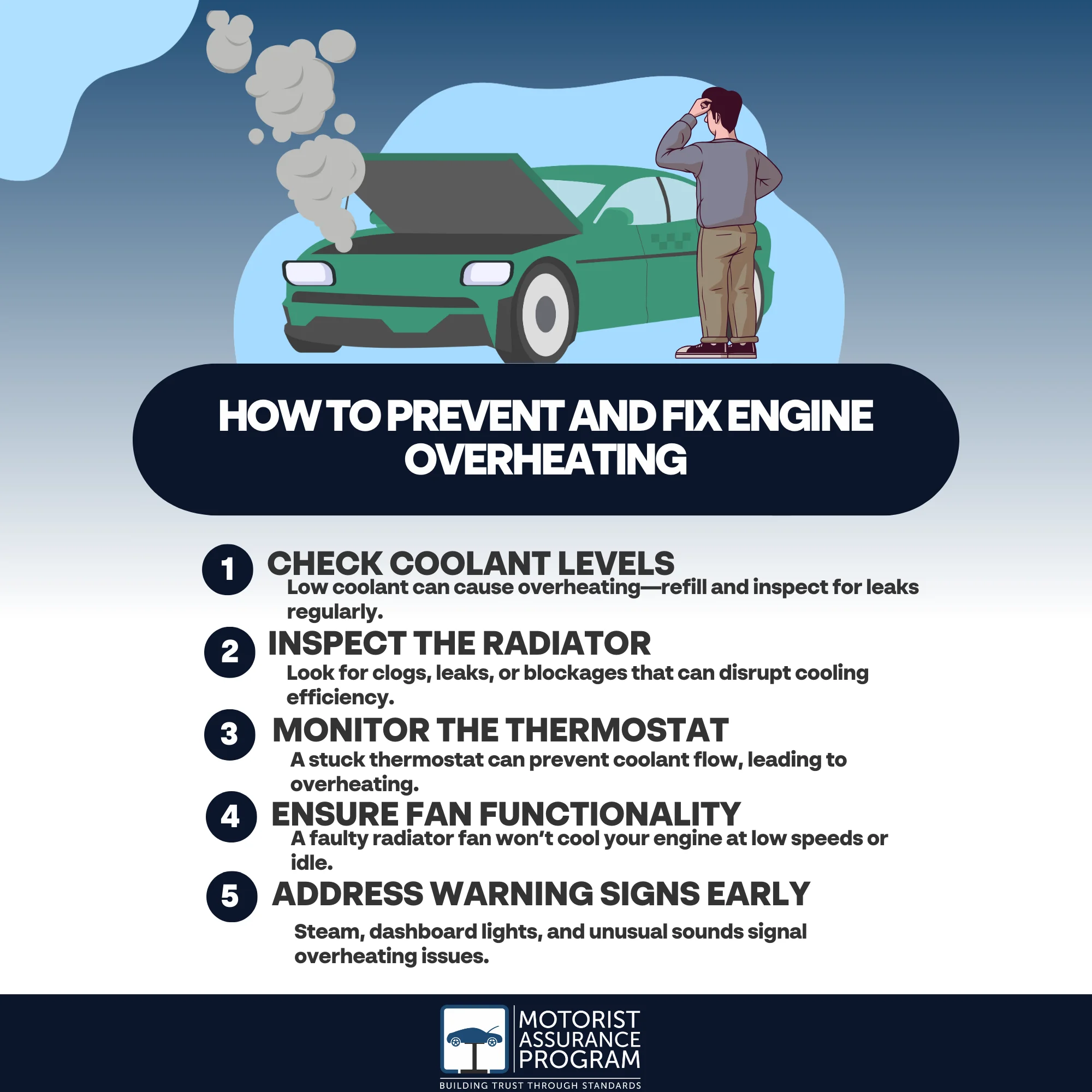If your engine’s overheating, start by checking the coolant level and inspecting for leaks around hoses and the radiator. Make sure the radiator fan’s working properly and that the thermostat isn’t stuck. If you see any warning lights or unusual sounds, it could indicate deeper issues. Refilling coolant may help temporarily, but addressing the underlying problem is essential. For a thorough understanding of causes and solutions, you might want to explore further insights.

Key Takeaways
- Check coolant levels regularly; low coolant can lead to overheating and should be refilled as necessary.
- Inspect the radiator for blockages, damage, or leaks that could impede proper cooling.
- Examine the thermostat to ensure it is functioning correctly, as a stuck thermostat can disrupt coolant flow.
- Verify the radiator fan’s operation; a malfunctioning fan may fail to cool the engine at low speeds.
- If overheating persists after initial checks, consult a mechanic for further diagnosis and repairs.
What is an engine?
An engine is the heart of your vehicle, powering it to move and perform. It converts fuel into mechanical energy, driving your wheels and enabling various functions. However, issues can arise, such as car engine overheating problems, leading to serious damage if not addressed promptly. Overheating typically occurs due to a lack of coolant, a malfunctioning thermostat, or a faulty water pump. When your engine gets too hot, it can cause warping or even complete failure. To prevent this, regularly check coolant levels and inspect hoses for leaks. If you notice your temperature gauge rising, it’s important to stop and assess the situation immediately. Keeping your engine in check guarantees longer life and better performance for your vehicle.
What is the difference between an engine and a cooling system?
Understanding the engine’s role in your vehicle leads naturally to the importance of the cooling system. The engine generates heat during operation, and without a cooling system, that heat can lead to serious car overheating problems. The engine is designed to convert fuel into mechanical energy, while the cooling system’s job is to maintain ideal operating temperatures.
It circulates coolant to absorb excess heat and dissipate it through the radiator. If the cooling system fails, the engine can overheat, leading to costly damage. Consequently, while the engine powers your vehicle, the cooling system guarantees it runs smoothly and efficiently. Keeping both in good condition is key to preventing car overheating problems and guaranteeing your vehicle operates as it should.
Why do engines overheat?
Engines can overheat for several reasons, and it’s essential to identify the culprit quickly. Common issues include a cooling system leak, a faulty water pump, or low coolant levels. You might also face problems with the radiator fan or a malfunctioning thermostat, all of which need your attention.
COOLING SYSTEM LEAK
Why might your engine be overheating? One common culprit is a cooling system leak. If there’s a leak in your radiator, hoses, or water pump, coolant can escape, leading to insufficient cooling. Without enough coolant circulating, your engine can’t maintain a safe operating temperature, which can cause car overheating problems. To check for a cooling system leak, look for puddles or wet spots under your vehicle. Inspect hoses for cracks or wear, and examine your radiator for any visible damage. If you notice any issues, it’s essential to address them quickly. Ignoring a cooling system leak can lead to severe engine damage, so make repairs as soon as possible to keep your engine running smoothly and prevent overheating.
FAULTY WATER PUMP
After checking for cooling system leaks, another potential reason for overheating could be a faulty water pump. This essential component circulates coolant through the engine and radiator. If it’s malfunctioning, the coolant won’t flow properly, leading to overheating. Signs of a faulty water pump include unusual noises, coolant leaks, or overheating even when coolant levels are adequate.
To fix car overheating problems related to a water pump, start by inspecting it for leaks or damage. If it’s faulty, you’ll need to replace it. Be sure to check the timing belt or chain, as they may need replacing too. Once you’ve replaced the water pump, refill the coolant, and monitor the engine temperature to verify everything’s working correctly.
LOW COOLANT LEVELS
One common reason for overheating issues is low coolant levels, which can severely impact your engine’s ability to regulate temperature. If you notice your car overheating, it’s crucial to check the coolant level as part of your car overheating troubleshooting. Here are some signs that your coolant may be low:
- Dashboard warning light indicating low coolant.
- Steam coming from the engine.
- Frequent need to refill coolant.
- Coolant leaks under the vehicle.
- Poor heater performance during cold weather.
Addressing low coolant levels promptly can prevent severe engine damage. Always verify you maintain the right coolant level to keep your engine running smoothly and avoid overheating problems in the future.
RADIATOR FAN FAILURE
Low coolant levels aren’t the only reason your engine might overheat. Radiator fan failure can also lead to serious radiator problems, causing your car to overheat. The radiator fan helps cool the engine by drawing air through the radiator when you’re idling or driving at low speeds. If the fan isn’t working, the engine won’t receive adequate cooling, especially in stop-and-go traffic. You might notice your engine temperature gauge rising or hear unusual noises from the fan area. To check for radiator fan failure, listen for the fan operation when the engine’s hot, or inspect the fan’s electrical connections. If it’s not functioning, you’ll need to replace it to prevent further overheating issues.
THERMOSTAT FAILURE
While there are several factors that can lead to engine overheating, thermostat failure is a common culprit. When the thermostat fails, it can either stick open or closed, disrupting the engine’s cooling system. Here are some signs you might notice:
- Engine temperature gauge reading too high.
- Coolant leaking around the thermostat housing.
- Heater not blowing hot air.
- Unusual engine noises or knocking.
- Steam or smoke from the engine bay.
If you suspect thermostat failure, it’s essential to address it promptly. Ignoring this issue can lead to severe engine damage. By diagnosing and replacing a faulty thermostat, you can prevent one of the most common overheating problems in cars and keep your engine running smoothly.
Does the risk of overheating increase as a car gets older?
As cars age, the risk of overheating can indeed increase due to various factors that affect their performance and efficiency. One main issue is the wear and tear on essential components like the car radiator. Over time, your radiator may develop leaks or become clogged with debris, leading to car radiator problems overheating. Additionally, older vehicles often have worn hoses and degraded coolant, which diminish the cooling system’s effectiveness. Regular maintenance becomes vital as your car ages to help identify and address these issues before they escalate. If you neglect these factors, you might find yourself dealing with overheating problems more frequently, leading to costly repairs down the line.
What are the signs of an engine overheating?
How can you tell if your engine is overheating? Recognizing the signs of an engine overheating can save you from costly repairs and potential breakdowns. Here are some key indicators to watch for:
- Warning Light: A dashboard warning light may illuminate.
- Temperature Gauge: If the temperature gauge is in the red zone, it’s a clear sign.
- Steam or Smoke: Visible steam or smoke from the engine compartment indicates overheating.
- Unusual Noises: Knocking or hissing sounds can suggest engine trouble.
- Loss of Power: If your engine struggles to accelerate, overheating could be the culprit.
Stay vigilant for these signs, and you’ll be better prepared to handle any overheating issues before they escalate.
How should you troubleshoot an engine that is overheating?
What steps can you take to troubleshoot an engine that’s overheating? First, check the coolant level; low coolant can lead to overheating. If it’s low, refill it and look for leaks. Next, inspect the radiator for blockages or damage. A blocked radiator can prevent proper cooling. Don’t forget to examine the thermostat; if it’s stuck closed, it won’t allow coolant circulation. Also, verify the radiator fan is functioning; a faulty fan can contribute to overheating. Finally, look for any warning lights on the dashboard. By following these steps, you’ll be on your way to understanding how to solve car overheating problems effectively. If these checks don’t reveal the issue, consider consulting a mechanic for further diagnostics.
What should you do if your car overheats in the middle of nowhere?
Experiencing an overheating car in a remote area can be stressful, especially if you’ve already checked for common issues like coolant levels and radiator function. When your car overheats, here’s what to do:
- Pull over safely and turn off the engine.
- Wait for the engine to cool down before opening the hood.
- Check the coolant reservoir and refill if necessary.
- Look for leaks or damage around hoses and the radiator.
- Call for roadside assistance if needed.
Staying calm and following these steps can help you handle the situation effectively. Knowing what to do when your car overheats can save you from further damage and guarantee your safety until help arrives.
Frequently Asked Questions
How Can I Prevent My Engine From Overheating?
To prevent your engine from overheating, keep your coolant levels topped up, regularly check for leaks, replace old hoses, and guarantee your radiator’s clean. Also, avoid heavy loads during hot weather to maintain peak performance.
What Tools Do I Need to Diagnose Overheating Issues?
To diagnose overheating issues, you’ll need a few essential tools: a coolant temperature gauge, infrared thermometer, pressure tester, and a multimeter. These tools help pinpoint the problem accurately and prevent further engine damage.
Is It Safe to Drive With an Overheating Engine?
Is it really safe to drive with an overheating engine? You should avoid it; continued driving can cause severe damage. If your engine’s overheating, pull over and let it cool down before proceeding. Your vehicle will thank you!
What Are Common Myths About Engine Overheating?
You might think that adding coolant fixes overheating, but that’s a myth. Overheating often indicates deeper issues like a failing thermostat or radiator. Ignoring these can lead to serious engine damage, so don’t overlook them.
How Often Should I Check My Coolant Levels?
You should check your coolant levels regularly, ideally every month or before long trips. Keeping an eye on it helps prevent overheating and guarantees your engine runs smoothly. Don’t forget to top it off when needed!
Conclusion
In summary, keeping your engine cool is vital for avoiding costly repairs and ensuring a smooth ride. By knowing the signs of overheating and how to troubleshoot, you can tackle these issues before they escalate. Remember, it’s better to be proactive than to end up stranded like a knight without his trusty steed. So, stay vigilant and don’t hesitate to explore the engine bay when needed. Your car will be grateful for it!


